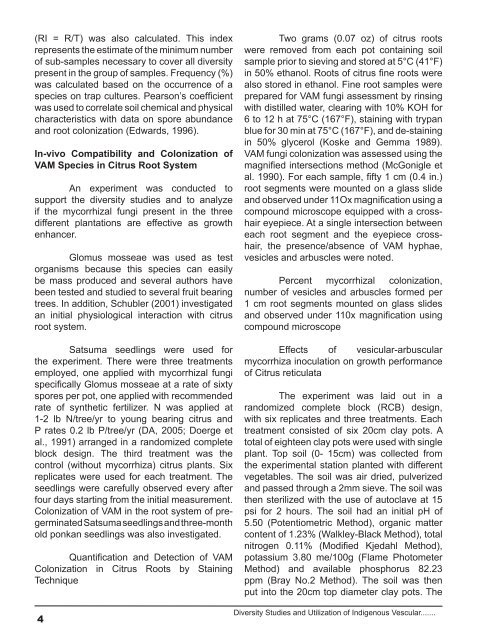download the full article here - EISRJC
download the full article here - EISRJC
download the full article here - EISRJC
Create successful ePaper yourself
Turn your PDF publications into a flip-book with our unique Google optimized e-Paper software.
(RI = R/T) was also calculated. This index<br />
represents <strong>the</strong> estimate of <strong>the</strong> minimum number<br />
of sub-samples necessary to cover all diversity<br />
present in <strong>the</strong> group of samples. Frequency (%)<br />
was calculated based on <strong>the</strong> occurrence of a<br />
species on trap cultures. Pearson’s coefficient<br />
was used to correlate soil chemical and physical<br />
characteristics with data on spore abundance<br />
and root colonization (Edwards, 1996).<br />
In-vivo Compatibility and Colonization of<br />
VAM Species in Citrus Root System<br />
An experiment was conducted to<br />
support <strong>the</strong> diversity studies and to analyze<br />
if <strong>the</strong> mycorrhizal fungi present in <strong>the</strong> three<br />
different plantations are effective as growth<br />
enhancer.<br />
Glomus mosseae was used as test<br />
organisms because this species can easily<br />
be mass produced and several authors have<br />
been tested and studied to several fruit bearing<br />
trees. In addition, Schubler (2001) investigated<br />
an initial physiological interaction with citrus<br />
root system.<br />
Satsuma seedlings were used for<br />
<strong>the</strong> experiment. T<strong>here</strong> were three treatments<br />
employed, one applied with mycorrhizal fungi<br />
specifically Glomus mosseae at a rate of sixty<br />
spores per pot, one applied with recommended<br />
rate of syn<strong>the</strong>tic fertilizer. N was applied at<br />
1-2 lb N/tree/yr to young bearing citrus and<br />
P rates 0.2 lb P/tree/yr (DA, 2005; Doerge et<br />
al., 1991) arranged in a randomized complete<br />
block design. The third treatment was <strong>the</strong><br />
control (without mycorrhiza) citrus plants. Six<br />
replicates were used for each treatment. The<br />
seedlings were care<strong>full</strong>y observed every after<br />
four days starting from <strong>the</strong> initial measurement.<br />
Colonization of VAM in <strong>the</strong> root system of pregerminated<br />
Satsuma seedlings and three-month<br />
old ponkan seedlings was also investigated.<br />
Quantification and Detection of VAM<br />
Colonization in Citrus Roots by Staining<br />
Technique<br />
Two grams (0.07 oz) of citrus roots<br />
were removed from each pot containing soil<br />
sample prior to sieving and stored at 5°C (41°F)<br />
in 50% ethanol. Roots of citrus fine roots were<br />
also stored in ethanol. Fine root samples were<br />
prepared for VAM fungi assessment by rinsing<br />
with distilled water, clearing with 10% KOH for<br />
6 to 12 h at 75°C (167°F), staining with trypan<br />
blue for 30 min at 75°C (167°F), and de-staining<br />
in 50% glycerol (Koske and Gemma 1989).<br />
VAM fungi colonization was assessed using <strong>the</strong><br />
magnified intersections method (McGonigle et<br />
al. 1990). For each sample, fifty 1 cm (0.4 in.)<br />
root segments were mounted on a glass slide<br />
and observed under 11Ox magnification using a<br />
compound microscope equipped with a crosshair<br />
eyepiece. At a single intersection between<br />
each root segment and <strong>the</strong> eyepiece crosshair,<br />
<strong>the</strong> presence/absence of VAM hyphae,<br />
vesicles and arbuscles were noted.<br />
Percent mycorrhizal colonization,<br />
number of vesicles and arbuscles formed per<br />
1 cm root segments mounted on glass slides<br />
and observed under 110x magnification using<br />
compound microscope<br />
Effects of vesicular-arbuscular<br />
mycorrhiza inoculation on growth performance<br />
of Citrus reticulata<br />
The experiment was laid out in a<br />
randomized complete block (RCB) design,<br />
with six replicates and three treatments. Each<br />
treatment consisted of six 20cm clay pots. A<br />
total of eighteen clay pots were used with single<br />
plant. Top soil (0- 15cm) was collected from<br />
<strong>the</strong> experimental station planted with different<br />
vegetables. The soil was air dried, pulverized<br />
and passed through a 2mm sieve. The soil was<br />
<strong>the</strong>n sterilized with <strong>the</strong> use of autoclave at 15<br />
psi for 2 hours. The soil had an initial pH of<br />
5.50 (Potentiometric Method), organic matter<br />
content of 1.23% (Walkley-Black Method), total<br />
nitrogen 0.11% (Modified Kjedahl Method),<br />
potassium 3.80 me/100g (Flame Photometer<br />
Method) and available phosphorus 82.23<br />
ppm (Bray No.2 Method). The soil was <strong>the</strong>n<br />
put into <strong>the</strong> 20cm top diameter clay pots. The<br />
4<br />
Diversity Studies and Utilization of Indigenous Vescular.......

















